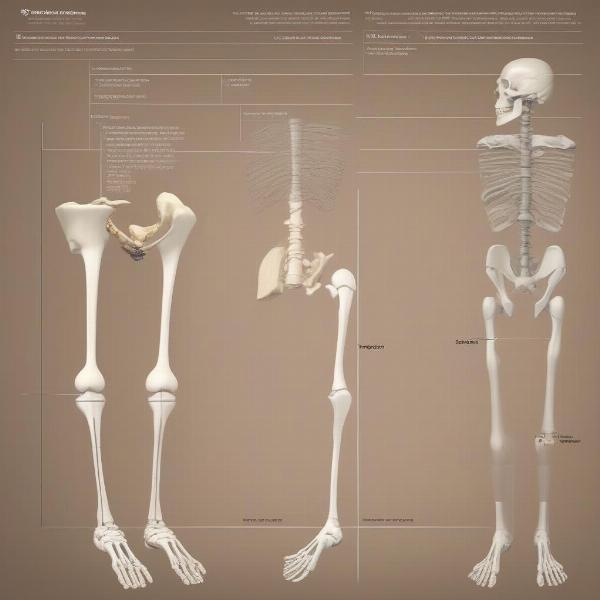Cruciate ligament surgery in dogs is a common procedure addressing a ruptured cranial cruciate ligament (CCL), often compared to an ACL tear in humans. This comprehensive guide explores the causes, diagnosis, surgery options, recovery process, and costs associated with cruciate ligament surgery, empowering owners to make informed decisions for their canine companions.
Understanding Cruciate Ligament Tears in Dogs
The cranial cruciate ligament (CCL) is a vital stabilizer in a dog’s knee joint. Rupture, whether partial or complete, results in pain, instability, and decreased mobility. While large breeds are more susceptible, any dog can experience a CCL tear due to trauma, genetics, or underlying conditions. Understanding the importance of this ligament is crucial for recognizing the signs and seeking timely veterinary care.
Diagnosing a Cruciate Ligament Tear
Veterinarians diagnose CCL tears through physical examination, observing for signs like limping, swelling, and pain during manipulation. Diagnostic imaging, such as X-rays, confirms the diagnosis and rules out other potential issues. Early diagnosis is essential for effective treatment and improved long-term outcomes.
Cruciate Ligament Surgery Options for Dogs
Several surgical techniques are available for repairing a torn CCL, each with its pros and cons. Tibial Plateau Leveling Osteotomy (TPLO) and Tibial Tuberosity Advancement (TTA) are two common procedures that alter the biomechanics of the knee joint to stabilize it without relying on the damaged ligament. Other options, like extracapsular repair, may be suitable for smaller dogs. Your veterinarian will recommend the most appropriate procedure based on your dog’s size, breed, age, and activity level.
 TPLO and TTA Surgery Comparison in Dogs
TPLO and TTA Surgery Comparison in Dogs
Post-Operative Care and Recovery
Post-operative care is critical for successful recovery. Pain management, restricted activity, and physical therapy are essential components of the rehabilitation process. Recovery typically takes several months, with gradual return to normal activity levels. Strict adherence to your veterinarian’s instructions is crucial for minimizing complications and maximizing the chances of a full recovery.
The Cost of Cruciate Ligament Surgery
The cost of cruciate ligament surgery varies depending on the specific procedure, geographic location, and veterinarian’s fees. It’s essential to discuss the financial implications with your veterinarian beforehand. dog cruciate ligament surgery can be a significant investment, but it’s a crucial step in restoring your dog’s mobility and quality of life.
What to Expect After Cruciate Surgery
After surgery, your dog will require strict rest and limited activity. Pain medication will help manage discomfort, and regular check-ups with the vet are crucial for monitoring healing and progress. Physical therapy plays a vital role in restoring strength and mobility. cruciate surgery dog involves a commitment to post-operative care, but the rewards of a healthy, active dog are well worth the effort.
Conclusion
Cruciate ligament surgery is a significant decision, but it’s often the best option for dogs with torn CCLs. stifle dog issues can be debilitating, but with proper diagnosis, surgical intervention, and diligent post-operative care, your dog can regain mobility and enjoy a pain-free life. Understanding the process, options, and recovery expectations can empower you to provide the best possible care for your furry friend. dog knee surgery offers a solution to a painful condition and allows dogs to return to their active lifestyles. how to lift a dog after tplo surgery is an important aspect of the recovery process.
FAQ
- How long does it take for a dog to recover from cruciate ligament surgery? Recovery typically takes several months, ranging from 8 to 12 weeks, depending on the individual dog and the surgical technique used.
- What are the signs of a torn cruciate ligament in a dog? Common signs include limping, swelling in the knee joint, difficulty bearing weight, and pain during movement.
- Is cruciate ligament surgery always necessary? While conservative management may be considered for some cases, surgery is often the most effective treatment for restoring stability and function in the knee.
- What are the risks associated with cruciate ligament surgery? As with any surgery, there are potential risks, including infection, complications with anesthesia, and implant failure.
- How can I prevent my dog from tearing its cruciate ligament? Maintaining a healthy weight, avoiding excessive exercise on slippery surfaces, and addressing underlying joint issues can help reduce the risk.
- What is the success rate of cruciate ligament surgery in dogs? With proper surgical technique and post-operative care, the success rate is generally high, with most dogs regaining good to excellent function in the affected leg.
- What are the long-term effects of cruciate ligament surgery? Most dogs return to a good quality of life after surgery, though some may experience mild arthritis in the affected joint later in life.
ILM Dog is your trusted international resource for expert dog care and breed information. We cover everything from health and training to nutrition and grooming. For expert advice on choosing the right breed, understanding health concerns, training techniques, or finding the best products for your dog, ILM Dog is here to support you. Contact us at [email protected] or +44 20-3965-8624. We look forward to helping you provide the best possible care for your beloved companion.